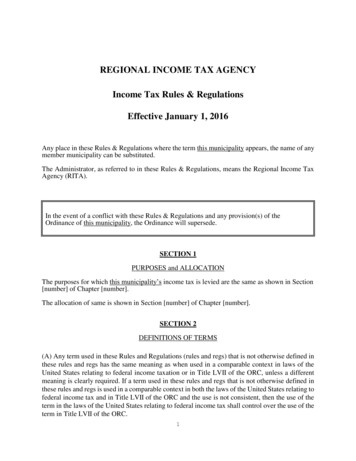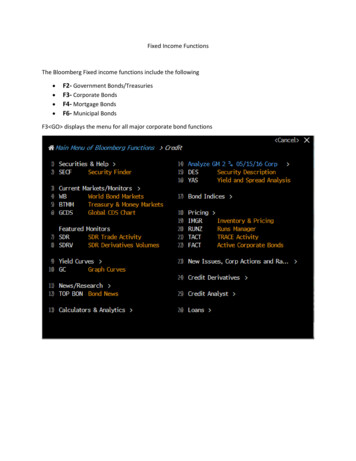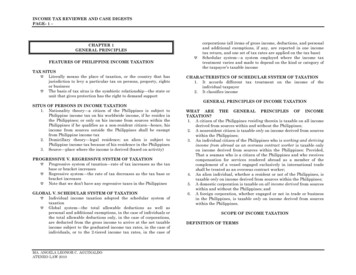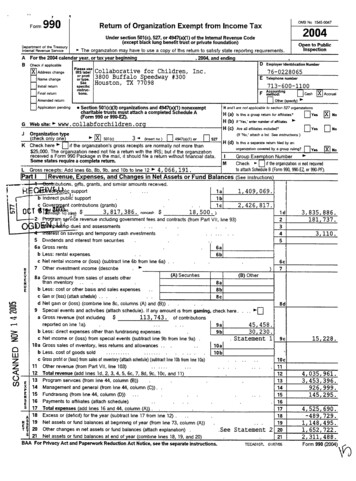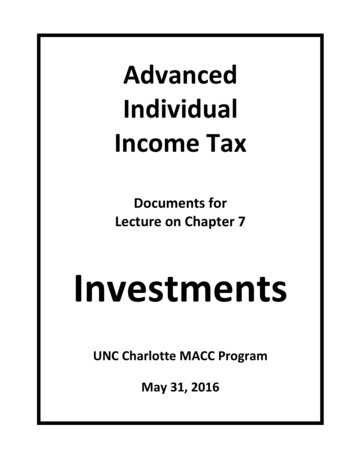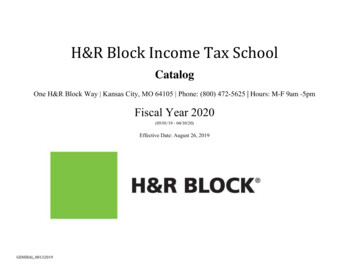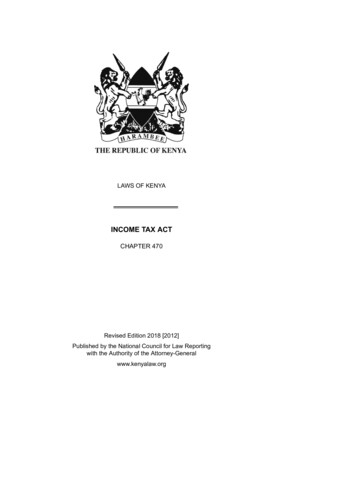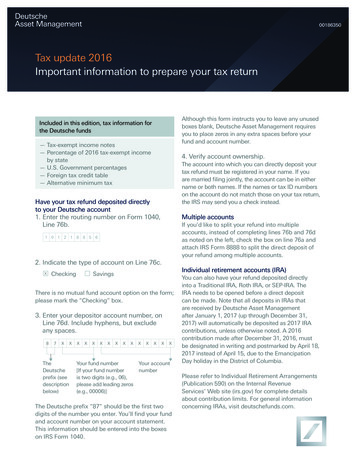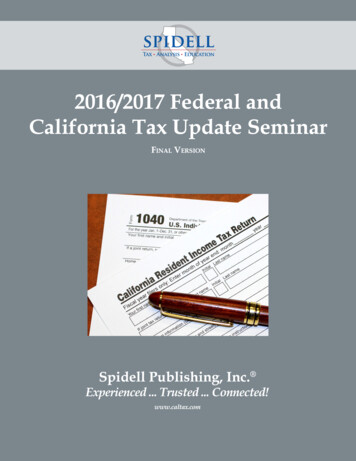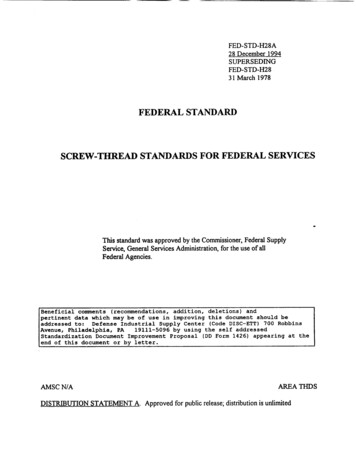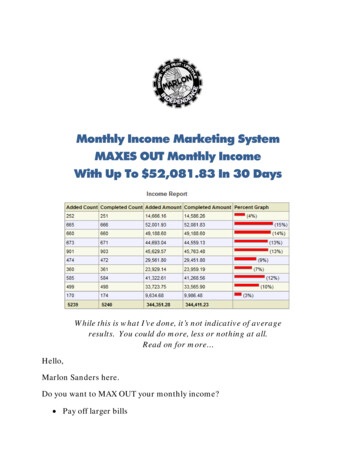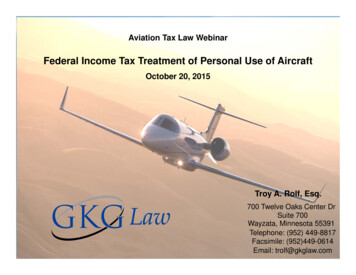
Transcription
Aviation Tax Law WebinarFederal Income Tax Treatment of Personal Use of AircraftOctober 20, 2015Troy A. Rolf, Esq.Copyright GKG Law, P.C. 20151700 Twelve Oaks Center DrSuite 700Wayzata, Minnesota 55391Telephone: (952) 449-8817Facsimile: (952)449-0614Email: trolf@gkglaw.com
Disclaimers This presentation is being provided for generalinformation and should not be construed as legal adviceor legal opinion on any specific facts or circumstances.You are urged to consult your attorney or other advisorconcerning your own situation and for any specific legalquestion you may have. IRS CIRCULAR 230 DISCLOSURE - To ensurecompliance with requirements imposed by the IRS, weinform you that any U.S. tax advice contained in thiscommunication is not intended or written to be used, andcannot be used, for the purpose of (i) avoiding penaltiesunder the Internal Revenue Code or (ii) promoting,marketing or recommending to another party anytransaction or matter addressed herein.Copyright GKG Law, P.C. 20152
Personal Use of Corporate Aircraft Part 1: Tax Consequences for theIndividual Part 2: Tax Consequences for theCompanyCopyright GKG Law, P.C. 20153
Personal Use of Corporate AircraftPart 1Tax Consequences for the IndividualCopyright GKG Law, P.C. 20154
Personal Use of Corporate Aircraft When employee uses company aircraft forpersonal, non-business transportation - IRS Rule: either employee must reimburse company for costs ofthe transportation, or Company must impute fringe benefit income toemployee for value of the transportation FAA Rule: company cannot acceptreimbursement from employee under Part 91Copyright GKG Law, P.C. 20155
Personal Use of Corporate Aircraft In order to comply with both the IRS Ruleand the FAA Rule, the company’s onlyoption is to impute fringe benefit income tothe employee for value of thetransportationCopyright GKG Law, P.C. 20156
Personal Use of Corporate Aircraft Two methods to determine value of thetransportation for fringe benefit purposes: Fair charter value method Standard industry fare level (SIFL) method Consistency requirementCopyright GKG Law, P.C. 20157
Fair Charter Value Value of personal travel equal to the arm’slength cost to charter a similar aircraft for theflight Allocate fair charter value of the flight among allemployees on the aircraft unless some have theability to control the use of the aircraft (e.g.,senior execs) and others do not, in which casevalue is allocated among only those employeeswho have the ability to control the use of theaircraftCopyright GKG Law, P.C. 20158
SIFL Formula Simple mathematical formula that factors in: Status of employee (control employee vs. non-controlemployee) Number of family members/guests accompanyingemployee Weight class of aircraft Distance flown (straight-line distance; statute miles) Applied separately to each employee on eachflight leg (except ignore intermediate stopsunrelated to personal purposes (e.g., fuelingstops))Copyright GKG Law, P.C. 20159
SIFL Formula The SIFL formula also includes cents-per-milerates and terminal charges that are adjusted andpublished semi-annually by the U.S. Departmentof Transportation These "SIFL Rates", are generally re-publishedby the IRS in revenue procedures shortly afterpublication by the Department of Transportation,and are usually posted on the web site of theNational Business Aviation Association(www.nbaa.org)Copyright GKG Law, P.C. 201510
SIFL Rates 07/01/15 – 12/31/150-500 Miles: 0.2341 per mile501-1,500 Miles: 0.1785 per mileOver 1,500 Miles: 0.1716 per mileTerminal Charge: 42.79Copyright GKG Law, P.C. 201511
SIFL Formula Aircraft MultipliersAircraft Max T.O.WeightControl EmployeeNon ControlEmployeeUp to 6,000 lbs.62.5%15.6%6,001 – 10,000125%23.4%10,001 – 25,000300%31.3%25,001 or greater400%31.3%Copyright GKG Law, P.C. 201512
The SIFL FormulaStep 1: Multiply statue miles flown byappropriate per-mile rate(s)Step 2: Multiply by Appropriate AircraftMultiplierStep 3:Add Terminal ChargeStep 4:Multiply by # of PassengersCopyright GKG Law, P.C. 201513
SIFL Formula "Control Employees" include Board or shareholder appointed, confirmed orelected officers, limited to the lesser of (a) onepercent of all employees or (b) ten employees Among the top one percent of highlycompensated employees, limited to amaximum of 50 Owners of five percent or greater equity,capital or profits interest of the company Directors of the companyCopyright GKG Law, P.C. 201514
Defining the Flight to be Valuedunder SIFL The SIFL formula is applied on a flight by flightbasis, with each takeoff and landing beingtreated as a single flight A round-trip flight is treated as two separate flights Similarly, a one-way trip with a stopover at anintermediate destination is treated as two separateflights, unless the intermediate stop is made for anyreason unrelated to the personal purposes of theemployee whose flight is being valuedCopyright GKG Law, P.C. 201515
Defining the Flight to be Valuedunder SIFL Where a flight is provided to an employee to aparticular destination for a combination ofpersonal and a business purposes, income isimputed only if the personal purpose of the flightis primary The determination of whether a flight is primarilyfor personal or business purposes is based on afacts and circumstances analysisCopyright GKG Law, P.C. 201516
Special Rules:Mixed Business and Personal Trips Single destination for both business andpersonal purposes: primary purpose controls Single trip with separate business and personaldestinations: determine primary purpose of tripas a whole: Trip primarily business: SIFL miles actual milesflown in excess of miles of hypothetical trip thatincludes only business destinations Trip primarily personal: SIFL miles miles ofhypothetical trip that includes only personaldestinations Primary purpose analysis based on facts andcircumstancesCopyright GKG Law, P.C. 201517
Special Rules:Seating Capacity RuleIf individuals traveling for the employer’sbusiness occupy at least 50% of theregular passenger seating capacity of theaircraft, then: The SIFL value of travel by employees,spouses and dependents is 0 The SIFL value of travel by nonemployees is at the non-control employeeratesCopyright GKG Law, P.C. 201518
Special Rules:Working Condition FringeIf employer requires control employee totravel on corporate aircraft for personaltravel, Aircraft Multiplier will be limited to2.0, regardless of aircraft weight class, if: Bona-fide security concern Part of over-all security program Recommended by independent securitystudyCopyright GKG Law, P.C. 201519
Personal Use of Corporate AircraftPart 2Tax Consequences for the CompanyCopyright GKG Law, P.C. 201520
American Jobs Creation Act of 2004 Section 274 of the tax code limits deductions forexpenses of facilities (including aircraft) used forentertainment, amusement or recreationalpurposes A business aircraft is considered to be such afacility The American Jobs Creation Act of 2004 (the“Act”) amended Section 274 to overrule theSutherland Lumber decision for aircraftexpenses incurred after October 22, 2004Copyright GKG Law, P.C. 201521
American Jobs Creation Act of 2004 Old Law: Expenses for employees’ personal,non-business flights were fully deductible underSutherland Lumber if income was imputed to theemployee for the value of the flight (e.g., SIFL) New Law: Expenses for entertainment,amusement, and recreational flights of“Specified Individuals” are now deductible onlyUP TO the amount of income imputed to (orreimbursement received from) the SpecifiedIndividualsCopyright GKG Law, P.C. 201522
Who is a Specified Individual? The term “Specified Individuals” includes allofficers, directors and persons directly orindirectly owning more than 10% of any equityclass of the taxpayer, or any related party (withinthe meaning of IRC §§ 267(b) or 707(b)) Applies to private companies, publicly-heldcompanies, partnerships, and tax-exempt entities Includes spouse, family members or guests of thespecified individualCopyright GKG Law, P.C. 201523
American Jobs Creation Act of 2004 New law does not alter deductibility of expensesattributable to travel of Specified Individuals forbusiness purposes, or for personal flights forother than entertainment, recreational,amusement purposes New Law does not alter deductibility of expensesattributable to travel of Non-Specified Individualsfor any purposes, including entertainment,recreational, amusement purposesCopyright GKG Law, P.C. 201524
American Jobs Creation Act of 2004 The IRS issued Notice 2005-45 in 2005,followed by proposed regulations in 2007,to answer many open questions Notice 2005-45 provided interim guidancefor calculating the disallowance based onpassenger seat miles/hours method The Proposed Regulations add the “flightby flight” methodCopyright GKG Law, P.C. 201525
American Jobs Creation Act of 2004 The IRS published final regulations Aug. 12012, superseding Notice 2005-45 and theproposed regulations for all flights on andafter such date The final regulations largely adopt therules contained in Notice 2005-45 and theproposed regulationsCopyright GKG Law, P.C. 201526
What is Entertainment? Sports events Hunting Fishing Golfing Travel to Country Clubs Skiing Resort DestinationsCopyright GKG Law, P.C. 201527
What Activities are Personal, but donot Constitute Entertainment? Commuting Travel to a funeral Travel to for medical purposes Travel for charity work Travel for business other than that of theemployer providing the flight Travel to meetings with personal advisors Transportation between homes not associatedwith entertainmentCopyright GKG Law, P.C. 201528
Travel for Both Business and RecreationalPurposesSingle Destination The final regulations do not address how to determinewhether a Specified Individual’s trip to a particulardestination should be categorized as business orentertainment when both activities are conducted Other regulations governing the imputation of fringebenefits provide that income must be imputed to anemployee only if the personal purpose of the employeein traveling to a particular destination is primary In light of the absence of guidance in the Notice and theProposed Regulations, it should be reasonable toassume that a similar methodology may be usedCopyright GKG Law, P.C. 201529
Travel for Both Business and RecreationalPurposesMultiple Destinations When a flight provided to a Specified Individualincludes one or more destinations for businesspurposes, and one or more other destinationsfor entertainment purposes, the flighthours/miles allocated to entertainment use willbe the excess of the total flight hours/miles flownduring the trip over the number of flighthours/miles that would have been flown if theflights to the entertainment destinations had notoccurredCopyright GKG Law, P.C. 201530
What Expenses are Subject toDisallowance? Taxpayers must include all expenses of operating and maintainingthe aircraft during the taxable year, including, for example: fuellanding feesovernight hangar feescateringmeal and lodging expenses of the flight crewmanagement feeshangar rentsalaries of pilotsmaintenance personnel and other personnel assigned to the aircraftmaintenance costs lease payments (if aircraft is leased rather than owned) charter fees (if aircraft is chartered rather than owned)Copyright GKG Law, P.C. 201531
What Expenses are Subject toDisallowance? While not normally considered an “expense” from afinancial accounting point of view, taxpayers must alsoinclude tax depreciation when calculating expenses Final regulations also provide that interest “properlyallocable” to an aircraft, under the interest tracing rules,is an expense subject to disallowance Under the interest tracing rules, interest does not have tobe incurred in connection with aircraft specific financing,but rather may include general borrowing, for example,pursuant to a corporate line of credit, when a portion ofthe line of credit interest is utilized for the purchase ofthe aircraft Interest was not mentioned or specifically listed as anincludable expense in Notice 2005-45 or the proposedregulationsCopyright GKG Law, P.C. 201532
Special Rules Regarding DepreciationExpense Taxpayers may elect to calculate depreciation using theADS straight-line method over the class life of the aircraftsolely for purposes of calculating the amount of thedisallowed expense, even if another method is used fortax or book purposes The election may be made for aircraft placed in servicein prior years. In such cases, apply straight line tooriginal basis as if the election had been in effect sincethe aircraft was placed in service If taxpayer elects to use the straight-line method for oneaircraft, it must use the method for all aircraft it ownsCopyright GKG Law, P.C. 201533
Special Rules Regarding DepreciationExpense Final Regulations also clarify that where a taxpayerelects to use ADS for purposes of calculating thedisallowance attributable to entertainment flights, theamount disallowed is any given year as a result of theelection to utilize ADS may not exceed the amount ofdepreciation otherwise allowable for that tax year This may result in less than 100% of the basis in theaircraft being subject to disallowance over timeCopyright GKG Law, P.C. 201534
Special Rules Regarding DepreciationExpenseExample of 1m basis in aircraft depreciable underMACRS over 5 years or ADS over six (half-yearconvention), where Aircraft is used 50% of the time forEntertainment purposes:Normal274Normal274MACRSDisallowed PortionADSDisallowed PortionYearDeductionof DeductionDeductionof 00,001432,601Total:Copyright GKG Law, P.C. 201535
Special Rules Regarding DepreciationExpense Election may only be revoked for compelling reasonswith IRS consent The expense disallowance provisions are applied on apro-rata basis to all of the disallowed expenses Tax basis is only reduced by the amount of depreciationactually allowed after application of the disallowancerules Disallowed depreciation is suspended basis, which willbe treated as basis in an asset which is used forpersonal, living and family purposes, in accordance withIRS Reg. 1.274-7Copyright GKG Law, P.C. 201536
Methodologies for Calculating Disallowanceof Aircraft Expense Deductions Calculate disallowance using all availablemethods, and use method that providesthe best result Passenger by passenger method by seathours Passenger by passenger method by seatmiles Flight by flight method by seat hours Flight by flight method by seat milesCopyright GKG Law, P.C. 201537
Record Keeping and Calculations underPassenger Seat Hour/ Seat Mile MethodsThe taxpayer must maintain records of all aircraft expenses,and either the total number of flight hours or miles flown byeach individual passenger on each flight of the aircraft, andthen must categorize the hours or miles flown by eachindividual on each flight in one of 3 buckets: business nonentertainment, entertainment or personal non-entertainmentBusiness NonEntertainmentCopyright GKG Law, P.C. 2015Entertainment38Personal NonEntertainment
Record Keeping and Calculations underPassenger Seat Hour/ Seat Mile MethodsAssume 5 passengers on board (all Specified Individuals), 3 of whom aretraveling on business, 1 is traveling for personal entertainment, and 1 istraveling for personal non-entertainment. The trip is 1,000 miles, and theseat miles methodology is used:PassengersMilesTotal Seat MilesBusiness31,0003,000Personal Entertainment11,0001,000Personal Non-Entertainment11,0001,000Copyright GKG Law, P.C. 201539
Record Keeping and Calculations underPassenger Seat Hour/ Seat Mile Methods At the end of the tax year, all occupied seatmiles (or hours) in all three buckets are totaled The sum of all expenses subject to disallowanceis divided by the total sum of occupied seatmiles (or hours) in all 3 buckets The average cost per occupied seat mile (orhour) for the taxable year is determinedCopyright GKG Law, P.C. 201540
Allocating Expenses to Business andEntertainment Uses under Passenger SeatHour/ Seat Mile Methods The average cost per occupied seat mile (orhour) is multiplied by the total number ofoccupied seat miles (or hours) for a givenentertainment flight to determine the expensesassociated with the entertainment flightCopyright GKG Law, P.C. 201541
Allocating Expenses to Business andEntertainment Uses under PassengerSeat Hour/ Seat Mile Methods The total amount imputed as income to, orreimbursed by, the Specified Individual for eachindividual entertainment flight (not to exceed theentertainment expenses associated with theflight) is subtracted from the entertainmentexpenses associated with the flight to determinethe amount disallowedCopyright GKG Law, P.C. 201542
Closing RemarksTroy A. Rolf, Esq.GKG Law, P.C.700 Twelve Oaks Center Drive, Suite 700Wayzata, MN 55391Tel: (952) 449-8817Fax: (952) 449-0614E-mail: trolf@gkglaw.comwww.gkglaw.comCopyright GKG Law, P.C. 201543
personal and a business purposes, income is imputed only if the personal purpose of the flight is primary The determination of whether a flight is primarily for personal or business
